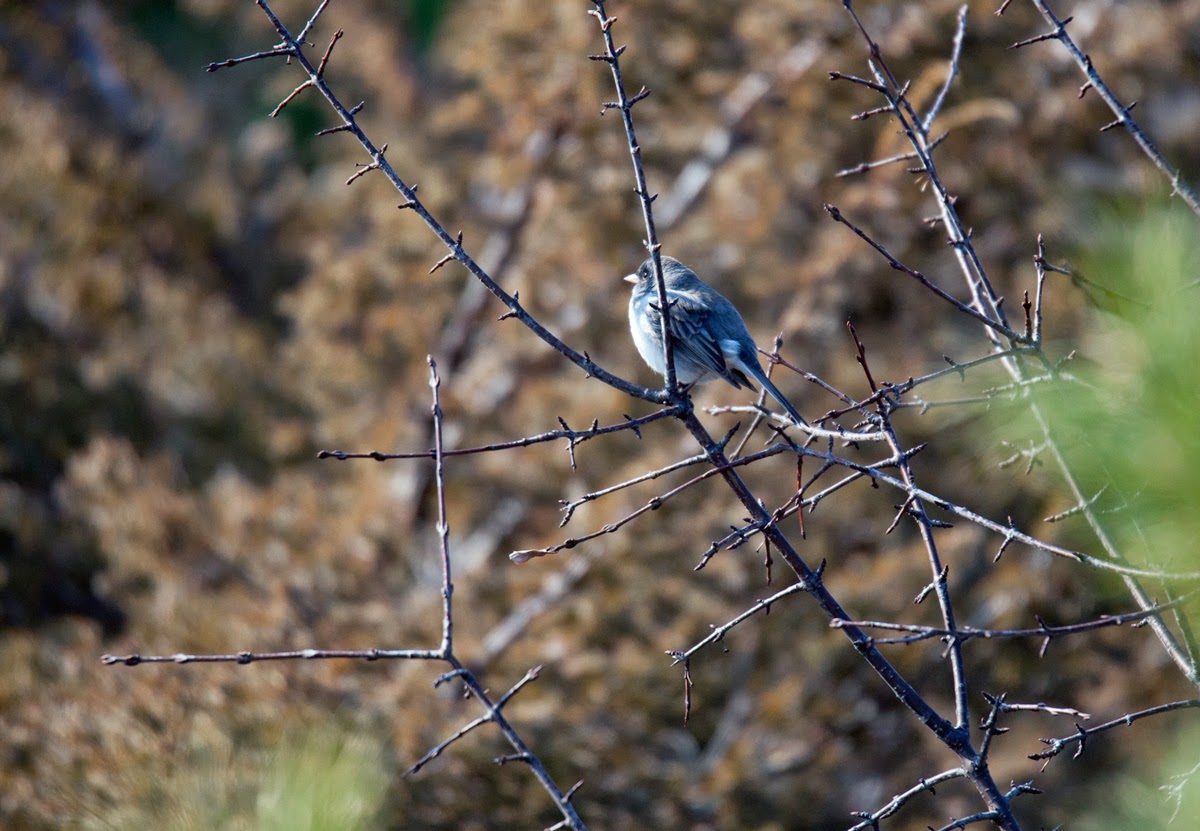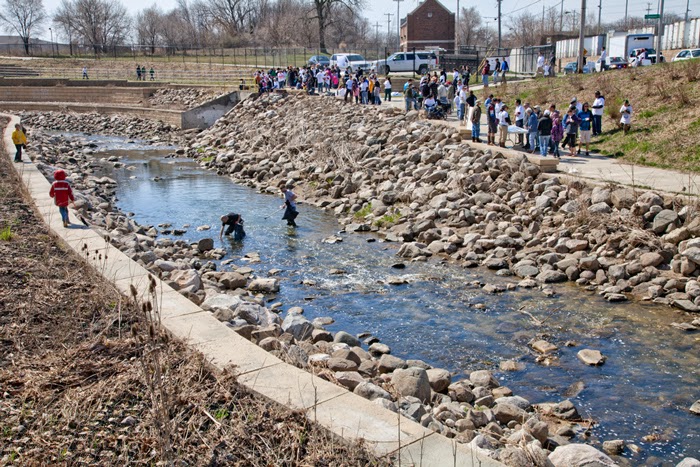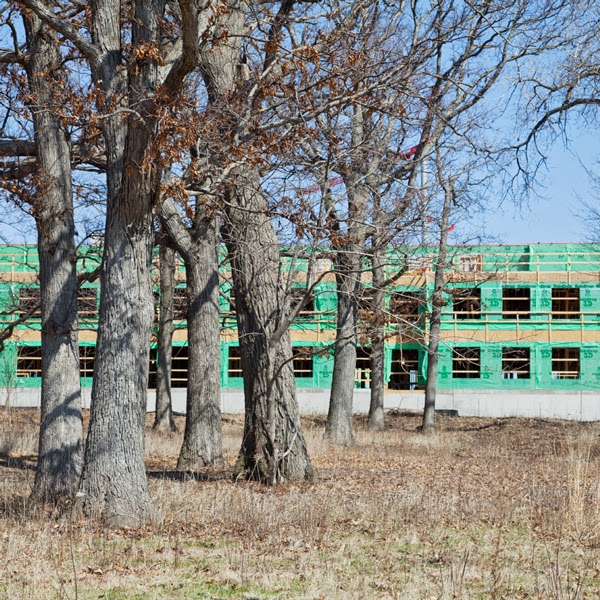This story was first
published (edited and with fewer photos) as a column for Milwaukee Magazine
with the title, A Bullseye View: A Milwaukee County park on Lake Michigan may
be threatened by a Cudahy gun club’s new shooting range.
A persistent, hollow rat-a-tat-tat echoed from somewhere
unseen, deepening the woods. Clearly a woodpecker; seemingly a large one. Then,
close by, a lighter tapping drew my eye upwards. Short bursts, like stitching,
repeated at irregular intervals. A small black and white downy woodpecker
flitted along the tree line next to the trail. Suddenly it was directly
overhead, tapping a dead branch. In a moment it was gone. Wildlife enthusiasts
live for such ephemeral moments.
I had come to Warnimont Park in early April with my friend
Karen Johnson, a birder who—unlike me—can tell a downy woodpecker from a
red-bellied one just by the sound it makes. We continued along the bike path,
listening, looking for movement amongst the trees, bright with morning sun but
still gray and leafless in the lingering Wisconsin winter. The light, lively
chatter, Karen said, was mostly chickadees that have been around all winter.
Their bright chirps vary from a high-pitched, serene “sweet-tee” to the
occasional, more urgent “chick-a-dee-dee-dee” for which they are named.
Although it is early in the season we were hoping to hear
and see a few of the migrating birds that congregate in Warnimont on their
annual trek north from distant wintering areas. We have two reasons for coming
to this particular park. The relative wildness of the middle section of the
park along with a diversity of habitats make it one of the premier locations in
Milwaukee County for birders. For my part, I wanted to see what might be lost
if a controversial plan to create a shooting range in the middle of it is
approved.
At its north end, next to Warnimont Golf Course, the park
currently has a shooting range that is slated to close. Operated by the 83-year
old Cudahy Sportsmen’s Club (CSC), the range has been used for decades by
gun-owners and, occasionally, by local law-enforcement. It also has been a
magnet for controversy. Its bluff-top location causes lead shot to be deposited
into Lake Michigan, a serious hazard to aquatic wildlife as well as a violation
of both the federal Clean Water Act and Resource
Conservation Recovery Act. As a result, the Milwaukee County Parks Department finally terminated the CSC’s lease in November, 2014.
When it faced identical circumstances, the Milwaukee Gun
Club, once located on the lakeshore at the north end of Lincoln Memorial Drive,
was compelled to close in 1992. At Warnimont, the Parks Dept. granted the club
a one-year extension, allowing operations to continue with the stipulation that
steel be used instead of lead shot. But a new controversy looms over the club’s
plan to relocate.
Karen and I continued to walk along the winding Oak Leaf Trail. She abruptly raised her binoculars to identify a small, yellowish shape
that shot across our path. A golden-crowned kinglet, she tells me with relish,
an early migrant. The woodland thins and opens into a broad meadow dotted with
low shrubs. Joggers and cyclists swerve around us on the trail.
We head off into the meadow on a dirt path, following a
stuttering call that Karen identifies as a song sparrow. Before long we are
doubly rewarded. We spot the song sparrow among brambles and then farther along
a dark-eyed junco perched atop a leafless bush.
Individually, the woodland and the meadow provide excellent
cover and distinct habitats for a wide variety of local and migrating birds.
Together, however, they create a remarkably diverse ecosystem, one that’s hard
to match in Milwaukee County. The convergence of two habitats, such as the
woods and the meadow, creates what naturalists call an ecotone or a point of
transition. The mingling of species that occurs in an ecotone makes for a
particularly rich environment for wildlife. This is what draws so many birders
to Warnimont.
The Cudahy Sportsmen’s Club would like to create its new
shooting range smack in the center of this county park’s exquisite and
irreplaceable natural area. According to CSC president Tom Ahmad, the design of
the range would include six trap and skeet machines, a tall shot curtain and an
earth berm between the range and the bluff. Also, unlike the current range, a
chain-link fence would surround the new one. The curtain and berm are necessary
to protect off-road cyclists, hikers and dog-walkers who frequent the bluff-top
path. They also would facilitate clean up of plastic shot wads and broken clay
targets, which has been another point of contention at the current site.
Bright, often toxic fragments of targets litter the steep, deeply eroded escarpment
and plastic wads drift onto popular beaches below.
To the untrained or utilitarian eye, a meadow in a park
might seem like the ideal place to develop—unruly grass in an already open
space. That’s one of the reasons upland meadows and prairies are among the most
endangered habitats in the country. But many bird species require precisely those
conditions. Its proximity to the Lake Michigan flyway makes Warnimont Park
especially attractive to seasonal migrants. The prospect of bulldozing this
exceptional landscape—a jewel in Milwaukee County’s park system—has ignited
passionate opposition.
Members of the local chapter of the Audubon Society are
incensed. The chapter has posted a petition online opposing the proposed
location of the shooting range, addressed to County Supervisor Jursik, whose
jurisdiction includes Cudahy. The petition has over 500 signatures. And birders
are not the only vocal opponents.
Jursik says that she has received calls from people opposed
to the proposal “for all kinds of reasons.” Park neighbors are alarmed that the
already disturbing noise of shooting would be moved closer to homes near S.
Lake Dr. Aurora St. Luke’s South Shore Hospital on S. Lake Dr. is “very
concerned” about it, Jursik says.
The gun club proposal, which has not yet been formally
submitted, would clear cut a very sensitive ecological area of mixed conifers,
hardwoods, and meadow—and one of the highest points on the western shore of
Lake Michigan. It also would move the heavily used Oak Leaf Trail away from the
rugged scenery along the bluff to a new route adjacent to S. Lake Dr. thus
diminishing the recreational experience. The vast majority of those users have
not heard of the proposal and therefore have not weighed in on the controversy.
Gun club members have framed their position as a gun rights
issue. “This is totally false,” says Jursik. “It has nothing to do with second
amendment rights.” The issue is appropriate land use in a beautiful public
park.
When the plan was first announced the club mounted a highly
visible public relations campaign to muster support, enlisting the aid of talk
radio. After an initial flurry of calls from club supporters, says Jursik, “in
the last 2-3 months, all of my calls have been in opposition.”
Milwaukee County is under no obligation to provide a place
for the gun club, according to Guy Smith, chief of operations for Milwaukee
County Parks. The club has other options on private land. Jursik says the Winchester
Gun Club in Racine is willing to accommodate them.
Parks Director John Dargle expects a decision to be made by
June, 2016, once a detailed proposal is submitted and after engineering and
environmental impact studies and public hearings are completed.
Although I’ve cycled through Warnimont on the Oak Leaf Trail
many times, I had never stopped to explore it until I learned of this issue. In
the past month I’ve returned several times. I’ve seen the snow melt away and
the first blush of spring buds begin to green the woodlands. Thanks to several
members of the Audubon Society I’ve seen a wider variety of birds than I knew
existed—and heard many more that went unseen. I’m looking forward to May when
the buds will have opened, grasses will have greened, and a full array of migratory
birds will arrive.
For more photos (along with captions) from Warnimont Park, click here.









































